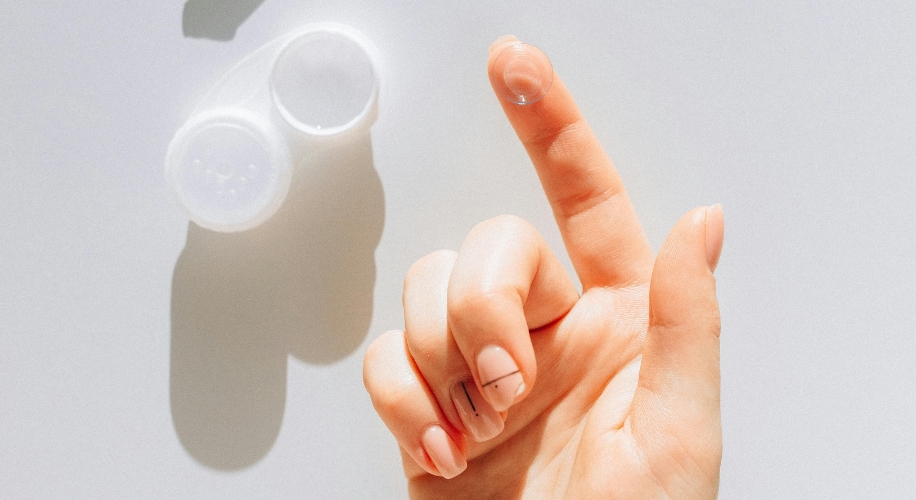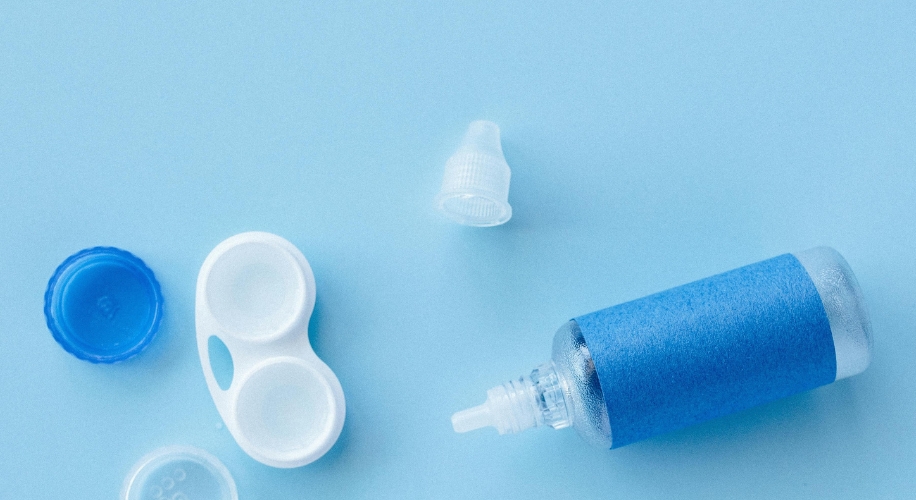What Is Contact Solution (And What’s in It)?
- BY Dr. Steven Liem
- IN Eye Care
If you wear contact lenses, you’re likely familiar with contact solution—an essential part of your daily eye care routine. But have you ever wondered what this solution is made of and how it works? In this blog, we’ll dive into the components of contact solution, its various types, and how it helps keep your lenses clean and your eyes comfortable.
Photo by Nataliya Vaitkevich
Understanding Contact Solution
Contact solution is a liquid used for cleaning, rinsing, or storing contact lenses. It is crucial for maintaining lens hygiene, preventing infections, and ensuring that your lenses remain comfortable throughout the day. Without proper care, contact lenses can accumulate debris and harmful microorganisms, leading to eye irritation and infections.
The Types of Contact Solution
Contact solutions generally fall into a few different categories, each designed for specific types of lenses and needs:
- Multipurpose Solution: A versatile solution that cleans, rinses, disinfects, and stores lenses. It is the most commonly used type because of its convenience and effectiveness.
- Hydrogen Peroxide Solution: Known for its strong disinfecting properties, this solution requires a special case with a neutralizing disc to convert hydrogen peroxide into water and oxygen. It is ideal for users with sensitive eyes or those who experience frequent lens discomfort.
- Protein Cleaner Solution: Designed to remove protein buildup on lenses, this enzymatic cleaner is often used in conjunction with other types of solutions. Protein deposits can accumulate on lenses over time, leading to discomfort and blurred vision.
- Saline Solution: Primarily used for rinsing lenses before insertion or after cleaning. It does not disinfect lenses but is gentle on the eyes and helps remove loose debris.
What’s in Contact Solution?
The effectiveness of contact solution lies in its carefully balanced chemical composition. Here’s a closer look at the key ingredients commonly found in contact solutions:
Salts and Electrolytes
Salts, such as sodium chloride, are used to match the natural tear fluid’s salinity, ensuring that the solution is isotonic. This balance prevents irritation and discomfort when the lenses are worn. Electrolytes like potassium and calcium can also be present to maintain the lens’s integrity and ensure proper hydration.
Disinfectants
Disinfectants are essential in contact solutions for eliminating harmful microorganisms such as bacteria, fungi, and viruses that may be present on your lenses. Different disinfectants serve various purposes:
- Hydrogen Peroxide: Known for its strong disinfecting properties, hydrogen peroxide effectively kills a wide range of pathogens. It is typically used in solutions that require a neutralizing disc to convert the hydrogen peroxide into harmless water and oxygen before lens insertion.
- Boric Acid: Often used in combination with other agents, boric acid helps maintain the pH balance of the solution and has mild antibacterial properties that assist in keeping lenses clean.
- Ascorbic Acid: While primarily known for its antioxidant properties, ascorbic acid can also help in the stabilization of other ingredients in the solution, ensuring effective disinfection and preventing degradation of the solution over time.
Photo by Shiny Diamond
Surfactants
Surfactants, or cleaning agents, help to break down and remove proteins, lipids, and other residues from the lenses. They work by reducing the surface tension of the solution, making it easier to clean the lenses effectively.
Preservatives
Preservatives are added to prevent the growth of bacteria in the solution itself. Common preservatives include:
- Benzalkonium Chloride: Effective in small concentrations, but can be irritating to sensitive eyes with prolonged use.
- EDTA (Ethylenediaminetetraacetic Acid): Often used in combination with other preservatives to enhance effectiveness.
Buffers
Buffers help maintain the pH level of the solution, ensuring it remains close to that of natural tears. This is important for preventing irritation and ensuring compatibility with your eyes and lenses.
Moisturizers
Many contact solutions contain a wetting agent or lubricant to enhance comfort and reduce dryness while wearing lenses.

Photo by Nataliya Vaitkevich
Choosing the Right Contact Solution
When selecting a contact solution, consider the type of lenses you use (soft or rigid gas permeable) and any specific needs you may have, such as sensitivity or frequent dryness. Always follow the instructions provided by your eye care professional and the solution manufacturer to ensure the best results and maintain your eye health.



